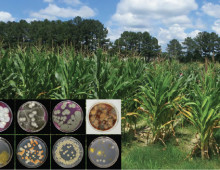FECB: A Functional Encyclopedia of Cyanobacteria
The DOE JGI’s Genomic Encyclopedia of Bacteria and Archaea (GEBA) project has been filling the genomic gaps in the prokaryotic tree of life. One offshoot of the project, called GEBA-Cyano, focuses on improving the understanding of the genetic basis of cyanobacterial ecophysiology. Cyanobacteria are eminently DOE mission-relevant organisms, playing key roles in global carbon and… [Read More]


